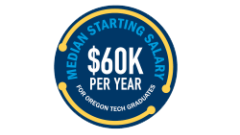Starting next year, Oregon Institute of Technology, “Oregon Tech,” will launch a bachelor’s degree in Data Science, a program created to answer the quickly growing need for analysts of “big data,” and the first undergraduate program of its kind at a public university in Oregon. First announced in January, the Higher Education Coordinating Commission (HECC) recently approved the degree for the university’s Klamath Falls campus.
In 2019, the employment website Glassdoor ranked “data scientist” as the “best job in America” for the fourth consecutive year. They found data scientists report a high job satisfaction rating and a high median salary. Data science is a rapidly growing field with jobs ranging from research in science and healthcare, to technology jobs within companies in marketing and targeted advertising. Other jobs include automated systems (cars that drive themselves for example) and governmental positions in data management and reporting. With an advanced degree, someone trained in data science could do research in a variety of fields including statistics, business/management, survey sampling, bioinformatics and many others.
Data scientists use skills from the fields of computer science, applied math and statistics to extract insights from data, helping companies and organizations to make well-informed decisions. In addition to technical skills, data scientists must be able to work as part of a team and communicate effectively.
The Bachelor of Science in Data Science degree at Oregon Tech combines coursework from five departments: Applied Mathematics (the program host), Computer Systems Engineering Technology, Communication, Management and Geomatics. The program curriculum was developed following guidelines recently set out in the National Academy of Sciences Report Data Science for Undergraduates: Opportunities and Options, as well as an analysis of the skills required by jobs in industry. A key element of the program is extensive hands-on experience.
Final touches in program design were aided by a technique from data science known as “web scraping.” Because of Oregon Tech’s commitment to meeting the needs of industry, an essential piece of the program design involved acquiring a list of skills companies are currently looking for when hiring a data scientist. While such a list could be obtained many ways, the University’s list was created by programming a computer to quickly collect (“scrape”) and analyze hundreds of job advertisements for data scientist positions posted online. Web scraping is a good illustration of the type of data science techniques that allow statistical analyses to be done quickly for large amounts of complex data.
During the first two years of the program, students will build foundational skills in computer programming and logical reasoning in mathematics, with some introductory topics in databases and data science workflows. Advanced skills are taught in the last two years. Beyond standard topics such as machine learning, the program will offer undergraduate students a unique opportunity to learn both techniques for handling geospatial data and state-of-the-art tools for understanding causes and effects rather than just simple correlation. In their junior year, students will apply material from previous classes in a series of group projects. As a culmination of the hands-on, interdisciplinary curriculum, students will work on an individual capstone project to develop a data driven solution for an outside group, such as a local business or national organization, during their senior year. After graduation, students will be ready for immediate employment as data scientists or for advanced coursework in a variety of graduate programs.
Oregon Tech will launch the Data Science program at the Klamath Falls campus, with possible expansion to its Portland-Metro campus or Online campuses that will be determined based on students and market demand.
###









